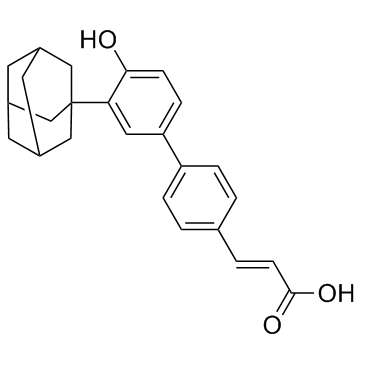496868-77-0
| Name | (E)-3-[4-[3-(1-adamantyl)-4-hydroxyphenyl]phenyl]prop-2-enoic acid |
|---|---|
| Synonyms |
Adarotene [INN]
3-(4'-hydroxy-3'-adamantylbiphenyl-4-yl)acrylic acid Adarotene UNII-W6SU73VG8H ST1926 |
| Description | Adarotene is an effective apoptosis inducer, which surprisingly produces DNA damage and exhibites a potent antiproliferative activity on a large panel of human tumor cells. |
|---|---|
| Related Catalog | |
| In Vitro | Adarotene causes a dose-dependent growth inhibition in a large panel of human tumor cell lines with IC50 ranging from 0.1 to 0.3 µM. Adarotene causes cell accumulation in G1/S or S phase of cell cycle depending on tumor cells IGROV-1 and DU145[1]. Adarotene is apoptotic and cytotoxic on a large spectrum of cancerous and leukemic cells, including freshly isolated AML blasts in primary culture. The molecular target of ST1926 apoptotic activity in myeloid leukemia cells is similar to the ligand-binding domain of RARγ. Adarotene treatment of cells results in rapid accumulation of intracellular calcium[2]. |
| In Vivo | Adarotene (15, 20 mg/kg, p.o.) causes a significant tumor growth inhibition in a human ovarian carcinoma, A2780/DX, and in a human melanoma, MeWo, growing in nude mice[1]. Adarotene (30, 40 mg/kg, p.o.) results in a significant and dose-dependent increase in the life span of NB4-bearing SCID mice without overt toxicity[2]. |
| Cell Assay | Briefly, cells (1×107/mL) are loaded with 1 μM FURA-2 at 37°C in the dark for 30 minutes, washed twice, resuspended in phosphate-buffered saline (PBS) containing 1.26 mM CaCl2 at 106 cells/mL and then used for the experiments. Dual excitation, alternating at 340 nm and 380 nm, is provided by a spectrophotofluorometer equipped with 2 excitation monochromators, and emission is fixed at 480 nm. The temperature is set at 37°C±1°C. In some experiments, to eliminate extracellular calcium, cells preloaded with FURA-2 are resuspended in PBS without Ca2+, and 0.5 mM EGTA (ethylene glycol tetraacetic acid) is added to each sample prior to addition of the appropriate stimulus. |
| Animal Admin | NB4 cells (3×106) are intraperitoneally inoculated in SCID mice (8 mice/group). ST1926 is dissolved in cremophor/ethanol 1:1 solution, and diluted 1:10 in PBS at the concentration of 50 mg/kg; the doses of 30 mg/kg and 40 mg/kg are then prepared by appropriate dilutions in the same vehicle. ATRA is dissolved in the dark in Cremophor EL and kept magnetically stirred; the solution is then diluted 1:10 in PBS at the final concentration of 40 mg/kg. Both compounds are administered intraperitoneally and orally twice per day for 3 weeks starting from the day after cell inoculation, in a volume of 10 mL/kg. During treatments body weight and lethality are registered. |
| References |
| Molecular Formula | C25H26O3 |
|---|---|
| Molecular Weight | 374.47200 |
| Exact Mass | 374.18800 |
| PSA | 57.53000 |
| LogP | 5.62480 |
| Storage condition | -20°C |
